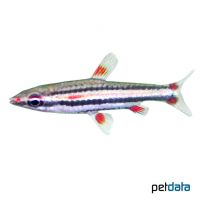Threestripe Pencilfish (Nannostomus trifasciatus)
| Threestripe Pencilfish Nannostomus trifasciatus | |
|---|---|
| Name | Threestripe Pencilfish |
| Name Lat. | Nannostomus trifasciatus |
| Family | Pencilfishes |
| Family lat. | Lebiasinidae |
| Order | Characins |
| Order lat. | Characiformes |
| Origin | South America |
| Habitat | Streams, ponds |
| Diet | Carnivore |
| pH | 5.0-7.0 |
| Behavior | Peaceful |
| Keeping | Group |
| Care Level | Moderate |
| Reproduction | Egg scatterer |
| Breeding | Moderately difficult |
| Life Span | 3-5 years |
| Protection | No |
| Metric Units | |
| Size | 3.5 cm |
| Temperature | 23-27 °C |
| Hardness | 1-12 °dH |
| Aquarium | 50 l |
| US Units | |
| Size | 1.4" |
| Temperature | 73-81 °F |
| Hardness | 18-214 ppm |
| Aquarium | 15 gal |
Distribution and habitat
Three-banded ornamental tetras are widely distributed throughout the Amazon River drainage, from Peru, Bolivia and Brazil to Guyana. They live in slow-flowing, small rivers and forest streams, as well as in stagnant waters such as ponds and floodplains with dense vegetation.
Maintenance
The aquarium should have soft, slightly acidic water and varied planting that provides both shelter and swimming space. A dark substrate covered with some foliage (e.g. sea almond leaves), some roots and shaded light (floating plant cover) is ideal.
No ammonia, ammonium and nitrite should be detectable, the nitrate value should not exceed 100 mg/l. To ensure the water quality and oxygen content, a filter and heater adapted to the aquarium size is required, as well as lighting for the species-appropriate day-night rhythm of the animals.
Diet
In the wild they feed mainly on small insects and larvae. The diet consists of small live foods such as cyclops, daphnia, artemia and mosquito larvae, which are also well accepted frozen, plus commercially available frozen special food mixtures. High-quality, protein-rich dry food (flakes, granules) is also usually accepted without problems.
A regular and varied diet promotes health and increases resistance. Only as much should be fed as is eaten immediately (in a maximum of 10 minutes).
Behaviour and compatibility
They are calm, attractive fish and well suited for any community tank with small peaceful fish. Males will defend their small territories against each other without serious fighting. At least 5, but preferably more Dreibinden ornamental tetras should be kept together.
In principle, only mutually compatible fish species with similar demands on water conditions and water temperature should be socialized.
Sex dimorphism
The males are more intensely colored, the females are stockier and have a rounder abdominal line.
Reproduction and breeding
The males form small territories, preferably with fine-feathered plants (Java moss), into which females willing to spawn come. After 24-48 hours the larvae hatch and swim freely after 3-4 days
Fry must be fed several times a day with special rearing food (dust food). In community tanks breeding is hardly possible, because the spawn is easy prey.
Important
For camouflage, they change their color and markings in the dark to protect themselves from predators while sleeping.
The well-being of the fish should be checked regularly. Temperature should be checked daily, pH, hardness and nitrate levels should be checked at least every 14 days. Regular partial water changes are recommended, even when contaminant levels have not yet reached the upper limit. Sudden changes in water quality should be avoided. Newly introduced fish must be accustomed slowly to the water in the aquarium.
Further literature can be found in your pet store.
References
Text: petdata; Image: petdata
Source: BMELV (1998): Tierschutzgutachten - Haltung von Zierfischen (Süßwasser); RIEHL & BAENSCH (2006): Aquarien Atlas Bd. 1, Mergus Verlag; ENGELMANN (2005): Zootierhaltung - Tiere in menschlicher Obhut: Fische, Verlag Harri Deutsch
- Gemäß § 21 Abs. 5 Tierschutzgesetz idgF
